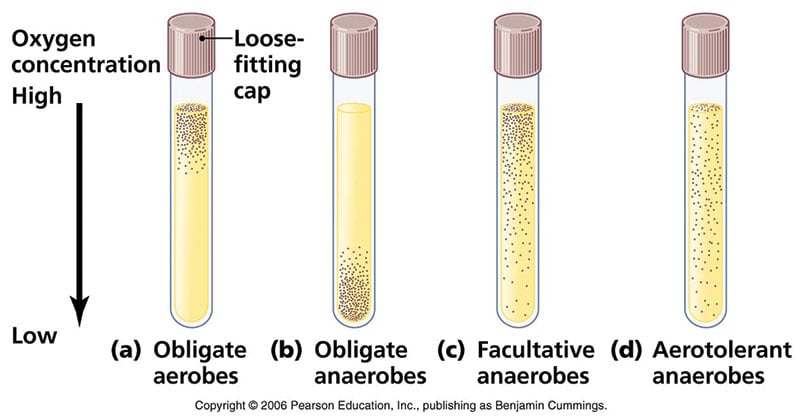Thioglycolate broth is a multipurpose, enriched, differential medium used primarily to determine the oxygen requirements of microorganisms. It acts as an enrichment broth which is most frequently used in diagnostic bacteriology. This broth supports the growth of anaerobes, aerobes, microaerophilic, and fastidious microorganisms.

Image Source: Prince George’s Community College
Interesting Science Videos
Composition of Thioglycollate Broth
| Ingredients | Gms/liter |
| L-cystine | 0.50 |
| Sodium chloride | 2.50 |
| Glucose | 5.50 |
| Yeast extract | 5.00 |
| Pancreatic digest of casein | 15.0 |
| Sodium thioglycollate | 0.5 |
Final pH (at 25°C): 7.1 ± 0.2
Principle of Thioglycollate Broth
- Dextrose, pancreatic digest of casein, yeast extract, L-cystine provide the growth factors necessary for bacterial multiplication.
- L-cystine and sodium thioglycollate allows Clostridium and other strict anaerobes to grow in this medium even under aerobic conditions.
- Sodium thioglycollate act as a reducing agent and neutralizes the toxic effects of mercurial preservatives and peroxides formed in the medium, thereby promoting anaerobiosis, and making the medium suitable to test materials containing heavy metals.
Aerobic and anaerobic bacteria can be identified by growing them in test tubes of thioglycolate broth:
- Obligate aerobes need oxygen because they cannot ferment or respire anaerobically. They gather at the top of the tube where the oxygen concentration is highest.
- Obligate anaerobes are poisoned by oxygen, so they gather at the bottom of the tube where the oxygen concentration is lowest.
- Facultative anaerobes can grow with or without oxygen because they can metabolize energy aerobically or anaerobically. They gather mostly at the top because aerobic respiration generates more ATP than either fermentation or anaerobic respiration.
- Microaerophilic need oxygen because they cannot ferment or respire anaerobically. However, they are poisoned by high concentrations of oxygen. They gather in the upper part of the test tube, but not the very top.
- Aerotolerant organisms do not require oxygen as they metabolize energy anaerobically. Unlike obligate anaerobes, though, they are not poisoned by oxygen. They can be found evenly spread throughout the test tube.
Preparation and Method of Use of Thioglycollate Broth
- Suspend 29g in 1 liter of distilled water.
- Bring to the boil and dissolve the medium completely.
- Distribute into tubes or bottles and sterilize by autoclaving at 121°C for 15 minutes.
Note: Prepare freshly or boil and cool the medium just before use - Inoculate the medium following aseptic technique.
- Once inoculated, the broth should be incubated at 35-35°C as soon as possible.
Result Interpretation on Thioglycollate Broth
| Organisms | Growth |
| Candida albicans | Flocculent growth |
| Clostridium sporogenes | Turbid growth and or colonies |
| Peptostreptococcus anaerobius | Turbid growth and or colonies |
| Clostridium perfringens | Turbid growth and or colonies |
| Bacteroides fragilis | Turbid growth and or colonies |
| Bacteroides vulgatus | Turbid growth and or colonies |
| Staphylococcus aureus subsp. Aureus | Turbid growth and or colonies |
| Pseudomonas aeruginosa | Turbid growth and or colonies |
| Micrococcus luteus | Turbid growth and or colonies |
| Streptococcus pneumoniae | Turbid growth and or colonies |
| Escherichia coli | Turbid growth and or colonies |
| Salmonella Typhimurium | Turbid growth and or colonies |
| Salmonella Abony | Turbid growth and or colonies |
Uses of Thioglycollate Broth
- Thioglycollate broth is recommended for the cultivation of aerobic, microaerophilic, and anaerobic microorganisms.
- It allows the differentiation of obligate aerobes, obligate anaerobes, facultative anaerobes, microaerophiles, and aerotolerant organisms.
- It is intended for sterility testing with certain biological products that are turbid or otherwise do not lend themselves readily to culturing in Thioglycollate Medium because of its viscosity.
- It is recommended for sterility testing of antibiotics, biologicals, and foods and for determining the phenol coefficient and sporicidal effect of disinfectants.
- When anaerobic infection is suspected, thioglycollate medium is recommended to isolate strict anaerobes from the blood.
- Thioglycollate broth is used to find out the growth characteristics of various bacteria based on their oxygen requirements.
Limitations of Thioglycollate Broth
- It is essential that the medium should be freshly prepared or boiled and cooled within four hours of use.
- Storage at lower temperatures increases oxygen absorption.
- Thioglycollate media should not be re-heated more than once because toxic oxygen radicles are formed on reheating.
References
- https://www.sciencedirect.com/topics/immunology-and-microbiology/thioglycollate-broth
- http://www.oxoid.com/UK/blue/prod_detail/prod_detail.asp?pr=CM0391&cat=&c=UK&lang=EN
- http://himedialabs.com/TD/M009.pdf
- http://www.austincc.edu/microbugz/fluid_thioglycollate_medium.php
- http://iws2.collin.edu/dcain/CCCCD%20Micro/thioglycollatebroth.htm

The top must be left open slightly? not screwed tightly?
I prepared the thioglycolate according to the formula, but after 121℃ sterilization and 15 min cooling, there were AGAR clots, and the liquid was a little cloudy,why?
It’s recommended that it be stored in the dark. Why?
very good
Some reserche keeeping thioglycolat at 37C for 2weeks befor using it
Whats your opinion ?